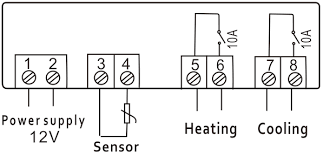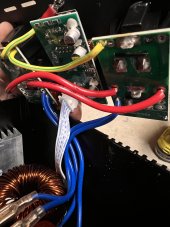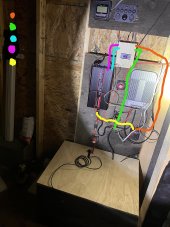You are using an out of date browser. It may not display this or other websites correctly.
You should upgrade or use an alternative browser.
You should upgrade or use an alternative browser.
Small system to power small freezer
- Thread starter Sonnyboy
- Start date
pollenface
Solar Addict
What if I wired them to a manual cut off switch and activated them manually when the days were overcast?
You could or you could just leave the system over-paneled permanently (while staying within a safe VOC range)
Better yet, get another SCC and split your array between them.
pollenface
Solar Addict
Out of curiosity, which SCC do you have?I have 3,000W of panels on a 500W controller.
I have the Epever 40amp oneOut of curiosity, which SCC do you have?
MichaelK
Solar Wizard
I have Midnight controllers, and I know they will automatically clip off the peaks once the set limit is reached. For 48V, my set limit is 65A. I see my controller doing that around noon or so. It's not to much clipped off because of the panel orientation.So if I add say 600 or 1200 additional watts of panels to my system on overcast days will that fry my controller? When you say you are overpaneled, are you over your limit for what your controller can handle but because of placement it works? I would like to not have to upgrade to 24v at this time.
Whether or not the budget model of the budget brand does exactly the same, I can't say for sure. What it's "supposed to do" and what it "actually can do" could be two different things. I"m assuming you don't want to find out by trying to run 80A through it.
yeah but if I wire them the way you suggest I am just over wattage not over the controller 40ampsI have Midnight controllers, and I know they will automatically clip off the peaks once the set limit is reached. For 48V, my set limit is 65A. I see my controller doing that around noon or so. It's not to much clipped off because of the panel orientation.
Whether or not the budget model of the budget brand does exactly the same, I can't say for sure. What it's "supposed to do" and what it "actually can do" could be two different things. I"m assuming you don't want to find out by trying to run 80A through it.
I’ll check out the Midnight controllers
pollenface
Solar Addict
I was actually asking @efficientPVI have the Epever 40amp one
efficientPV
Solar Addict
- Joined
- Sep 24, 2019
- Messages
- 1,348
I have a makeskyblue.Out of curiosity, which SCC do you have?
I don’t have two simple wires going to my rocker switch. I have it all on small boards with a white multithread cable going to it. Do you have any idea which is which?
Attachments
Leeds
Solar Enthusiast
- Joined
- Jul 7, 2022
- Messages
- 179
I have to admit that I'm not understanding where the rocker switch is seeing only the back view.
But if the issue is that the rocker switch is a thruhole part then there would be no easy wire to snip. Instead it would be a solder job where I'd solder a wire into each of the rocker through hole posts.
The difference would be that in the initial concept (snipped wire) the rocker switch would need to be on for the system to work and it would disconnect the output if you turned it off.
If you solder in parallel with the switch then the rocker switch would need to be off for the system to work and it would force on the output if you turned it on.
But if the issue is that the rocker switch is a thruhole part then there would be no easy wire to snip. Instead it would be a solder job where I'd solder a wire into each of the rocker through hole posts.
The difference would be that in the initial concept (snipped wire) the rocker switch would need to be on for the system to work and it would disconnect the output if you turned it off.
If you solder in parallel with the switch then the rocker switch would need to be off for the system to work and it would force on the output if you turned it on.
So I soldered it as you said and it ndeed this did preserve a lot of battery. Now, a strange thing happens. Been working as you described for a few days, now the inkbird switched on( batteries at 14v) and immediately, the inverter begins beeping and battery voltage drops to 10.4. If I shut off the inkbird it jumps back up.I don’t have two simple wires going to my rocker switch. I have it all on small boards with a white multithread cable going to it. Do you have any idea which is which?
Leeds
Solar Enthusiast
- Joined
- Jul 7, 2022
- Messages
- 179
That's the sort of behavior I'd expect from a bad battery.So I soldered it as you said and it ndeed this did preserve a lot of battery. Now, a strange thing happens. Been working as you described for a few days, now the inkbird switched on( batteries at 14v) and immediately, the inverter begins beeping and battery voltage drops to 10.4. If I shut off the inkbird it jumps back up.
If you unplug the fridge the inverter can probably power on for a while without tripping out like it does under load, right?
If I unplug the fridge, and keep the inkbird connected, yes, the inverter doesn't beep the warning. The batteries jump between 10.4-15v at random. The are brand new Weize lithium 100ah connected in parallel. So to be clear, the system says the batteries are at 14v, I switch on the Inkbird and the inverter beeps (low voltage error) and the batteries drop to 10v.That's the sort of behavior I'd expect from a bad battery.
If you unplug the fridge the inverter can probably power on for a while without tripping out like it does under load, right?
Leeds
Solar Enthusiast
- Joined
- Jul 7, 2022
- Messages
- 179
15V is just as troubling as the cutoff voltage of 10V, perhaps more so. What's allowing it to charge to this level?
But as for guessing- I'd say that you have a BMS that's cutting your battery off and back on to protect itself. I'd remove parts until the problem went away and then see what the last thing you removed was.
Make sure you don't have any charging devices on, solar panels, wall chargers, etc. 15V is too high a voltage for lifepo4, something is wrong there. If you leave the system alone for 1/2 hour with nothing overcharging it the battery should settle back to an acceptable level. Then try running the fridge.
If that doesn't help then unscrew the relay wires from the back of the inkbird and set the inverter toggle switch to the on position manually and see if the system fires up the fridge or kicks off again.
You have 2 batteries in parallel, right? Remove one and see if the problem goes away.
Somewhere in that list you'll probably stumble upon something that makes sense. If not, keep telling us about it someone on here knows whats going on here with your crazy 15-10v swings.
But as for guessing- I'd say that you have a BMS that's cutting your battery off and back on to protect itself. I'd remove parts until the problem went away and then see what the last thing you removed was.
Make sure you don't have any charging devices on, solar panels, wall chargers, etc. 15V is too high a voltage for lifepo4, something is wrong there. If you leave the system alone for 1/2 hour with nothing overcharging it the battery should settle back to an acceptable level. Then try running the fridge.
If that doesn't help then unscrew the relay wires from the back of the inkbird and set the inverter toggle switch to the on position manually and see if the system fires up the fridge or kicks off again.
You have 2 batteries in parallel, right? Remove one and see if the problem goes away.
Somewhere in that list you'll probably stumble upon something that makes sense. If not, keep telling us about it someone on here knows whats going on here with your crazy 15-10v swings.
Leeds
Solar Enthusiast
- Joined
- Jul 7, 2022
- Messages
- 179
One last thought, you didn't accidentally cross any of the wires in this diagram, did you?

There's no path from black to either green or blue right? And no path from red to either green or blue?
If you had shorted something in attaching this stuff it would not have worked at all. But it's still good to check your wiring.


There's no path from black to either green or blue right? And no path from red to either green or blue?
If you had shorted something in attaching this stuff it would not have worked at all. But it's still good to check your wiring.

No I don’t think anything is crossed or shorted. I disconnected one battery and now the other going down to 9v. The disconnected battery won’t charge with my trickle charger. While connected to that it is between 11-13v, when I disconnect it from the charger, back to 10v. I think those chargers don’t charge if you are below 11v. I wonder if I can hook up an agm battery fully charged to it to help it start charging? I’ve done that with lead acid in the past and it worked.
Leeds
Solar Enthusiast
- Joined
- Jul 7, 2022
- Messages
- 179
I've been re-reading your posts in this thread and it's clear that you've taken your batteries down to their cutout point a few times now. It's possible that one battery is dead or it's possible that you're just draining them down to 0 all the time.
One quick modification to the design will protect your batteries a bit better from the latter. If you run the inkbird's power through the courtesy relay in the charge controller the charge controller will cut off the inverter before the batteries drop below whatever the CC believes is appropriate.

One quick modification to the design will protect your batteries a bit better from the latter. If you run the inkbird's power through the courtesy relay in the charge controller the charge controller will cut off the inverter before the batteries drop below whatever the CC believes is appropriate.

So, your diagram is connecting to the "load" inputs on the SCC. Is that what you intended? I have never used the load outputs on a SCC. I have mine hooked up directly to the positive terminal of my fuse box and the negative directly to the negative bus bar. I programmed my SCC to cut off the battery draw as per the specs that came with the battery. Do you think that is not occurring now due to my setup? It is clearly not cutting them off by with the spec says.
"Once you get it woken up and trickle charging I'd wonder if the system runs better without the dead weight of the drained battery."
It ended up connecting without me having to trick it....its charging now.
"Did removing the dead one solve the issue?"
No, I think it killed the other battery. There is something wrong.
In this image attached, the inkbird is set up like this:
red: to positive bar of the fuse panel(I haven't fused that line with the 1amp fuse yet)
green: to neg buss bar
blue
purple: each to one end of the on/off switch
yellow: power fed from the battery line going into the inverter. This the problem?
"Once you get it woken up and trickle charging I'd wonder if the system runs better without the dead weight of the drained battery."
It ended up connecting without me having to trick it....its charging now.
"Did removing the dead one solve the issue?"
No, I think it killed the other battery. There is something wrong.
In this image attached, the inkbird is set up like this:
red: to positive bar of the fuse panel(I haven't fused that line with the 1amp fuse yet)
green: to neg buss bar
blue
purple: each to one end of the on/off switch
yellow: power fed from the battery line going into the inverter. This the problem?
Attachments
12VoltInstalls
life passes by too quickly to not live in freedom
That phrase is a classic bad connection symptom. I’m not convinced it’s the batteries.The batteries jump between 10.4-15v at random.
Similar threads
- Replies
- 6
- Views
- 173
- Replies
- 10
- Views
- 490
- Replies
- 0
- Views
- 96





